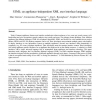Free Online Productivity Tools
i2Speak
i2Symbol
i2OCR
iTex2Img
iWeb2Print
iWeb2Shot
i2Type
iPdf2Split
iPdf2Merge
i2Bopomofo
i2Arabic
i2Style
i2Image
i2PDF
iLatex2Rtf
Sci2ools
CN
1999
1999
UIML: An Appliance-Independent XML User Interface Language
Today's Internet appliances feature user interface technologies almost unknown a few years ago: touch screens, styli, handwriting and voice recognition, speech synthesis, tiny screens, and more. This richness creates problems. First, different appliances use different languages: WML for cell phones; SpeechML, JSML, and VoxML for voice enabled devices such as phones; HTML and XUL for desktop computers, and so on. Thus, developers must maintain multiple source code families to deploy interfaces to one information system on multiple appliances. Second, user interfaces differ dramatically in complexity (e.g, PC versus cell phone interfaces). Thus, developers must also manage interface content. Third, developers risk writing appliance-specific interfaces for an appliance that might not be on the market tomorrow. A solution is to build interfaces with a single, universal language free of assumptions about appliances and interface technology. This paper introduces such a language, the U...
Appliances | Cell Phone | CN 1999 | User |
| Added | 22 Dec 2010 |
| Updated | 22 Dec 2010 |
| Type | Journal |
| Year | 1999 |
| Where | CN |
| Authors | Marc Abrams, Constantinos Phanouriou, Alan L. Batongbacal, Stephen M. Williams, Jonathan E. Shuster |
Comments (0)

